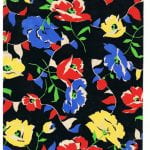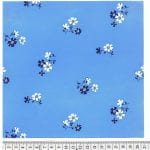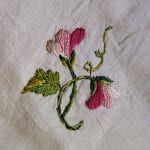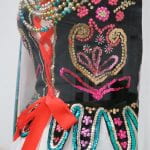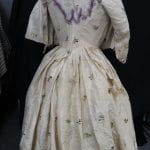The Walter Fielden Royle collection
Walter Fielden Royle
Walter Fielden Royle (1900-1981) was a freelance textile designer who worked in the mass production Manchester textile trade all his life, from the 20s and 30s. After his apprenticeship, starting at the age of 16 in a Manchester print design studio and working there for a few years, he established his own studio in 1926 employing others by the 1930s. With a break in WW2 when he served in the RAF, he again ran his own studio till he retired in 1961. In his lifetime, Fielden Royle was acknowledged as a leading and successful textile designer in Manchester, evidenced by the inclusion of his studio and illustrations of four of his designs in H.G.Hayes Marshall’s book of 1939, British Textile Designers Today.
When Fielden Royle died, the designs remaining unsold in his home were divided into three by his family. One third was given to Manchester Metropolitan University Archive Collection, one third was retained by Malcolm Ross, Fielden Royle’s nephew who now owns the copyright to this material, and one third was given to Ray Watkinson (art and design historian and respected writer on William Morris and the Pre-Raphaelites), who was Walter Fielden Royle’s brother-in-law. All three collections contain similar work, though MMU has some earlier examples than those in the University of Brighton group.
The Brighton collection contains 7 packets of 301 original designs on paper – 109 designs for women’s fashion fabrics and a further 201 designs for men’s shirtings. Every design is different from the other – hand painted on card, mostly by Fielden Royle. A few, mostly from the post WW2 period, appear to be designed by his studio colleagues with one packet of sheeting designs produced by an unknown designer, and colleague of Eric Ross, named Summerson, probably in about 1960.
The gift of Walter Fielden Royle artefacts to the University of Brighton
This collection consists of a rare group of over 330 unsold original fashion/dress and shirting designs produced by Walter Fielden Royle for the textile print trade in Manchester between 1926-1961.
In 1985, Ray Watkinson passed his group of designs to Lou Taylor, now Professor of Dress and Textile History in the School of Humanities, when they were both teaching in the Art History department of Brighton Polytechnic. In a letter dated 23rd October 1985, Ray Watkinson requested that the designs should be placed in ‘an A.H [Art History] archive’, rather than stored in the textile studios because design ‘students will look on these designs with a wondering eye but as the social history of design they ought to be very useful. I hope so.’ A second letter to Lou Taylor from Ray Watkinson of 10th March 1989, triggered by a student inquiry, added further information. These notes reveal Ray Watkinson’s own interests and personal memories related to the Manchester mass textile print trade in which his brother-in-law, Eric Ross, worked, and also Watkinson’s socialist political interests and his great expertise as a design historian and collector. Thus he wrote from his living experience, aided by specific design history knowledge about the 19th century design debates and with a rare realism and frankness about the work of the successful, mass production, freelance textile designers and attitudes to design in the Manchester cotton print trade in the 1930s.
Content of the University of Brighton Walter Fielden Royle Textile Print Collection comprises of 7 used brown paper envelopes, on which Ray Watkinson wrote a summary of their contents. Ray Watkinson noted in his letter of 1985 that
‘The packets put into my hand by my brother-in-law Eric, in tatty broken envelopes, whose dangers they have survived remarkably, fall into two categories, which would I am sure by the trade would be divided: shirtings and cretonnes, at least I’ve identified them as cretonnes – small scale lightish patterns mainly for dress fabrics I think.’
Ray Watkinson noted that the designs ‘had been de-mounted, I know not by whom, probably Walter’s widow so that they should take up less space.’ Thus nearly every design has signs of dried glue on the reverse, left after being detached from its mount. Usefully on the reverse most have been stamped with Fielden Royle’s studio addresses, often in multiples, placed there for copyright purposes. Through family records, the dates when Fielden Royle worked at these addresses are known. Most of the unsold designs in Packet 1 are address-stamped on reverse: ‘W. Fielden Royal. Textile Designer, Manchester, TEL URMSTON 244’ and thus date from the 1920s till 1929 when he ran a studio in his parents’ house, the Knolls, Cornhill Road, Davyhulme, Urmston. Other stamps show addresses at ‘W. Fielden Royle, Designer, 75, Princess Street, Manchester’ (probably 1946 into the 1950s) and three designs carry a stamp with his last studio address ‘W. Fielden Royal, Designer, 120, Portland St. Manchester CEN 28002’, probably covering the mid 1950’s till he retired in 1961.
About the online Walter Fielden Royle resource
This digital resource consists of images and descriptive catalogue listings of all the fashion print designs for women’s wear in the University of Brighton’s Walter Fielden Royle collection (FR1, FR2 and FR3.) The packets of men’s shirtings and sheet designs (FR4-7) have been sampled only as so many of these tiny designs are each so very similar to the other. Thus a sample only has been presented here. All of the 300 or so of these croquis designs are hand painted in flatly applied gouache paint on stiff card. Most are rectangular except for a very few on circular card. Three designs (FR1.10, FR1.15 and FR1.17) carry the price ’17/6′ in pencil on reverse, though Watkinson suggested in his letter of 23rd October 1985 that in the 1920s and 30s Fielden Royle might have earned 2 to 3 guineas per design sold. It must be remembered, firstly, that Fielden Royle created thousands of designs over the course of his lifetime as a textile designer and, secondly, that these designs are ones which remained unsold in his studio. Width sizes vary from 7.5 – 25cms. (Width direction has been assessed by the direction of the address stamps where present and by marks of glue along a top edge- left in place after de-mounting by Fielden Royle’s widow. If not, this has been guessed and indication written in pencil on reverse.)
We have no accurate information about which companies purchased Fielden Royle’s work. Once sold to the mass fashion textile and clothing print trade in Manchester, through an agent, or directly to the Manager of an in-house design studio for a large company like Tootals, or to the huge Calico Printers Association, Fielden Royle’s women’s fashion print designs became anonymous. They may have been used on cotton, rayon and silk blouses, dresses and into the widely used cotton overall pinafores made up by the many ready-to-wear companies in the region, and possibly for lingerie. We have so far been unable to find any information on this issue, beyond Ray Watkinson’s guess that some designs may been sold to the Calico Printers Association. The actuality is that Fielden Royle’s bold, colourful, fresh and endlessly varied designs were simply absorbed into the industry, desperate as it was for ‘novelty’ and continual change, even during the Depression years of the 1930s. As Watkinson also commented, a good few of Fielden Royle’s designs, targeted with professionalism at the mass roller print market (rather than for the more expensive screen-printed market) would anyway very probably have been altered in colour and print size for example and thus would become difficult to identify.
Watkinson commented that the status of the designer of these everyday prints was very low in the trade. They were never called ‘artists’ or artists—designers. He noted in his letter of October 23rd, 1985 that the term ‘Artist’ was a term ‘of abuse in the Cotton trade and always has been’. Rather, Watkinson stressed, the free-lance designer – like Walter Fielden Royle – had to know his place because he then he ‘should submit more readily to [the] altering [his designs] at the whim of the man who might or might not buy them: it indicates your willingness: it indicates your willingness to do this: and if English cotton print design is abysmally bad as so much of it has been, it is because we get the fruit of the wisdom and sensibility of the mill manager not the work of the designer.’ It is nonetheless possible to track designs in surviving garments and in period advertisements for example, that are close in mood to Fielden Royle’s work, if not exact reproductions.
One of the aims of this web site is to recover the history and imagery of the textile design work of Walter Fielden Royle and to place his professionalism, skill and creativity alongside that of well known textile designers of the same period, who worked for the far more expensive, better known ‘artist-designed,’ wood block or screen printed textile market – Paul Nash, Barron and Larcher and Joyce Clissold, for example. Fielden Royle was a designer of ‘everyday’ roller printed fabrics used widely in British ready-to-wear clothing for both men and women for nearly forty years from 1926. He is one of a lost and forgotten army of usually anonymous textile designers who have been the creative force within this Manchester trade throughout the city’s many centuries of producing thousand and thousands of miles of printed cottons and rayons. Walter Fielden Royle certainly deserves his place in that history. The University of Brighton Dress History Teaching Collection, with its clear interest in ‘everyday’ fashion and textile design, seems a fitting place where the resurrection of Fielden Royle’s name as an established, recognised, highly professional and creative textile designer from 1926 to 1961 should begin.
Copyright on the Walter Fielden Royle Collection
** Please note **
This is the only section of the University of Brighton Dress History Teaching Collection that requires formal copyright permission in published reproduction or for commercial use, because the copyright to these designs belongs to Walter Fielden Royce’s nephew, Malcolm Ross.
- For use of website images of the Fielden Royle Textile Print Collection 1920-60 by academic researchers/students in unpublished work, such a essays and seminar presentations: this is free, with acknowledgement to the copyright holder, Malcolm Ross and to the ‘University of Brighton Dress and Textile History Teaching Collection, School of Humanities, University of Brighton.’
- For use of website images of the Fielden Royle Textile Print Collection 1920-60 in academic publications, be it books or articles or digital publications: this is also free but formal permission must be sought from Malcolm Ross, the copyright holder and acknowledgement made to him and to the ‘University of Brighton Dress and Textile History Teaching Collection, School of Humanities, University of Brighton’ via Lou Taylor.
- Commercial use: for copyright permission and costs – contact Malcolm Ross, 17, Sunnyhurst Lane, Darwen, Lancashire, BB31JN and e-mail malcolmjross@hotmail.com.
Bibliography
- Farr, Michael, Design In British Industry, Cambridge University Press, 1955
- Hayes Marshall, H.G., British Textile Designers Today, F. Lewis, 1939
- Mary Schoeser, ‘Showey and Full of Work’, chapter in Mary Rose The Lancashire Cotton Industry, since 1700, Lancashire County Books, 1996
- Turnbull, G and Turnbull John G. (ed.) A History of the Calico Printing Industry of Great Britain, John Sherratt, 1951
- Lesley Jackson, 20th Century Pattern Design, Princeton Architectural Press, 2002

